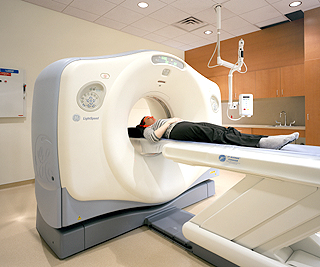
DJC.COM
August 25, 2005
Equipment issues complicate health care projects
Sellen Construction

Scalzo
|
In health care construction, there are many vital components that need to be addressed for a successful project: infection control, mechanical and electrical systems, specialized departments and medical equipment.
Although each area is integral to the project, medical equipment is one area that requires detailed planning, organization and a whole lot of teamwork.
The challenge associated with complex medical equipment is getting the latest technologically advanced machinery ordered and installed without affecting the construction schedule. Each project team member has certain responsibilities that need to be accomplished in order for equipment installation to go smoothly.
A balancing act
The owner faces many difficult questions during a construction project. It can be overwhelming, but with guidance from the architect and contractor, decisions are made so the project can proceed. For a health care client, the most important decision is the type of equipment that needs to be purchased.

Photo courtesy of Sellen Construction
Hospitals should wait as long as possible to order new medical equipment. Contractors must coordinate with other project team members to accommodate the late-arriving equipment.
|
Some of the more sophisticated machinery, including PET/CT scanners, MRIs and linear accelerators, continually evolve with better technology, so it's advantageous for the owner to order at the last possible opportunity.
The contractor must work with the owner to get the deadline established far enough into the schedule to take advantage of the latest technological advancements in equipment, but not long enough to delay the move-in date. It's a balancing act requiring strong interaction between the owner and contractor.
Coordinate the drawings
Once the owner has selected the equipment, the architectural, mechanical, electrical and equipment drawings need to be coordinated to avoid conflicts.
Areas that need to be examined and confirmed upon selection of the equipment are cabinetry and ceiling heights, laser-support heights, structural criteria and existing or new rough-in pipes, conduits, and ducts.
Architects should send drawings to the equipment provider for comment to further ensure continuity between the sets of drawings. It is then up to the contractor to ensure that the subs, architect, owner and equipment provider use the drawings for everything that needs to be built to eliminate mistakes.
Contractor concerns
The contractor has to coordinate many issues during construction including:
— Schedule constraints. Highly sophisticated equipment rooms take an enormous amount of team coordination to make them a success in the best conditions, let alone under the accelerated expectations common for today's projects.
Sellen was able to shorten a schedule by three days by closely coordinating the wall stud layout with the shielding layout. This ensured a faster installation and eliminated costly framing rework.
A key to this step was being aware that materials and equipment utilized for shielding can have long lead times and need aggressive planning.
— Shielding design. Different types of equipment have different shielding requirements, including magnetic, radio frequency, lead, steel and several-foot-thick concrete shielding.
The extent of shielding required must be evaluated depending on the equipment and use of the surrounding areas. The contractor needs to ensure all aspects of the shielding have been addressed, double-checked and triple-checked after all the equipment and existing conditions for the project have been established.
Often it is discovered late in construction that specifications have changed, requiring additional shielding and design rework. This applies both to the actual equipment rooms and adjacent areas.
— Mechanical and electrical systems. Equipment selection, user input and architectural coordination are all critical in order to get the layout for the equipment and control rooms right the first time.
The demands on the electrical system must be reviewed to determine if the existing electrical system has the capacity for the new equipment. Data and communications cabling are another key component to medical equipment.
Conduit must be coordinated with the equipment vendor and placed during construction so that cabling can be mounted during equipment installation.
Equipment may also have special venting requirements. For example, MRIs use liquid nitrogen to supercool the magnet's wires, and need exhaust systems that can handle venting at temperatures near absolute zero.
There should be walkthroughs before the wall cover is completed to ensure all backing, power data placement and venting are correct to the drawings, and more important, to the end user's true needs.
— Equipment installation. By the time the equipment has been ordered and delivered, installation is the last major task on this type of project.
Equipment is often installed in hospitals that operate 24 hours a day, and the contractor must minimize impacts to patient care while working near fully functioning areas.
Since equipment arrives late in the project schedule, the space must be nearly finished before the equipment arrives. It is therefore important to provide access for transporting equipment to its final location.
To do this, contractors may leave a portion of the exterior "open," leave corridors unfinished, maintain a large opening to the room or provide support for the transport path, since the equipment often exceeds floor-loading limits.
Some equipment, such as MRIs, can weigh several tons. In working with the owner and the design team, the contractor can review options for equipment access and a provide cost and constructability review of the structural upgrades to achieve the best solution.
There are also special construction requirements needed for high-tech equipment installation, including a pre-action sprinkler system, antistatic flooring, equipment-support structure and a unistrut rail system. Special care and attention are also required to contain construction-area dust, which can infiltrate sensitive patient care areas.
Although simple in concept, selecting and installing advanced medical equipment needs the full collaboration of the owner, architect and contractor to ensure a successful outcome.
There are many factors that need to be examined and planned in order for the health care facility, staff and patients to get the latest technology.
Dave Scalzo is a senior vice president and senior project manager at Sellen Construction, with over 22 years of health care construction experience.
Other Stories:
- Creative site selection opens doors
- Retailers have a role in health care system
- Hospitals have been slow to try green building
- Can't fund your building project? Try private capital
- Harborview wing getting a second skin
- Silence is golden — but rare — in a hospital
- Reaping the benefits of better design
Copyright ©2009 Seattle Daily Journal and DJC.COM.
Comments? Questions? Contact us.